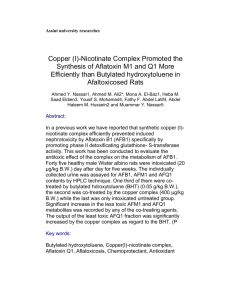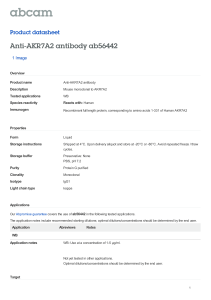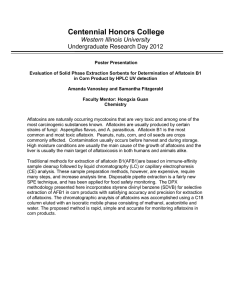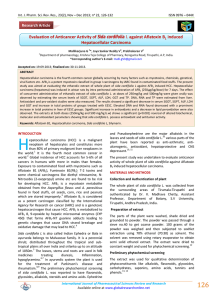Document 14840856
advertisement
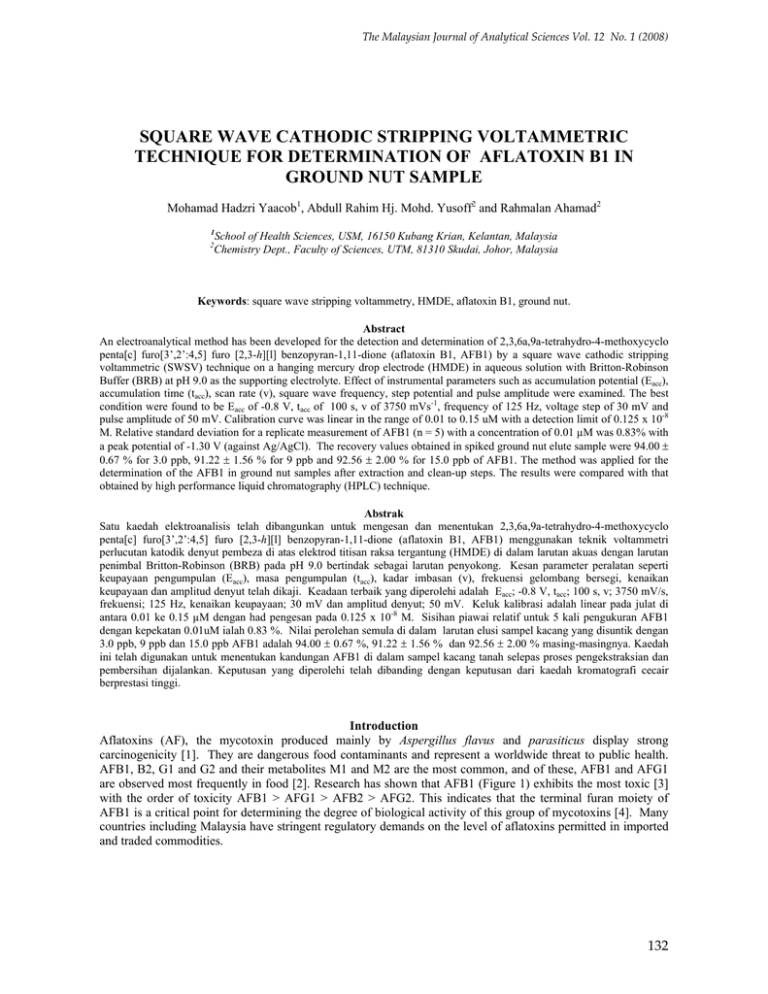
The Malaysian Journal of Analytical Sciences Vol. 12 No. 1 (2008) SQUARE WAVE CATHODIC STRIPPING VOLTAMMETRIC TECHNIQUE FOR DETERMINATION OF AFLATOXIN B1 IN GROUND NUT SAMPLE Mohamad Hadzri Yaacob1, Abdull Rahim Hj. Mohd. Yusoff2 and Rahmalan Ahamad2 1 School of Health Sciences, USM, 16150 Kubang Krian, Kelantan, Malaysia Chemistry Dept., Faculty of Sciences, UTM, 81310 Skudai, Johor, Malaysia 2 Keywords: square wave stripping voltammetry, HMDE, aflatoxin B1, ground nut. Abstract An electroanalytical method has been developed for the detection and determination of 2,3,6a,9a-tetrahydro-4-methoxycyclo penta[c] furo[3’,2’:4,5] furo [2,3-h][l] benzopyran-1,11-dione (aflatoxin B1, AFB1) by a square wave cathodic stripping voltammetric (SWSV) technique on a hanging mercury drop electrode (HMDE) in aqueous solution with Britton-Robinson Buffer (BRB) at pH 9.0 as the supporting electrolyte. Effect of instrumental parameters such as accumulation potential (Eacc), accumulation time (tacc), scan rate (v), square wave frequency, step potential and pulse amplitude were examined. The best condition were found to be Eacc of -0.8 V, tacc of 100 s, v of 3750 mVs-1, frequency of 125 Hz, voltage step of 30 mV and pulse amplitude of 50 mV. Calibration curve was linear in the range of 0.01 to 0.15 uM with a detection limit of 0.125 x 10-8 M. Relative standard deviation for a replicate measurement of AFB1 (n = 5) with a concentration of 0.01 µM was 0.83% with a peak potential of -1.30 V (against Ag/AgCl). The recovery values obtained in spiked ground nut elute sample were 94.00 ± 0.67 % for 3.0 ppb, 91.22 ± 1.56 % for 9 ppb and 92.56 ± 2.00 % for 15.0 ppb of AFB1. The method was applied for the determination of the AFB1 in ground nut samples after extraction and clean-up steps. The results were compared with that obtained by high performance liquid chromatography (HPLC) technique. Abstrak Satu kaedah elektroanalisis telah dibangunkan untuk mengesan dan menentukan 2,3,6a,9a-tetrahydro-4-methoxycyclo penta[c] furo[3’,2’:4,5] furo [2,3-h][l] benzopyran-1,11-dione (aflatoxin B1, AFB1) menggunakan teknik voltammetri perlucutan katodik denyut pembeza di atas elektrod titisan raksa tergantung (HMDE) di dalam larutan akuas dengan larutan penimbal Britton-Robinson (BRB) pada pH 9.0 bertindak sebagai larutan penyokong. Kesan parameter peralatan seperti keupayaan pengumpulan (Eacc), masa pengumpulan (tacc), kadar imbasan (v), frekuensi gelombang bersegi, kenaikan keupayaan dan amplitud denyut telah dikaji. Keadaan terbaik yang diperolehi adalah Eacc; -0.8 V, tacc; 100 s, v; 3750 mV/s, frekuensi; 125 Hz, kenaikan keupayaan; 30 mV dan amplitud denyut; 50 mV. Keluk kalibrasi adalah linear pada julat di antara 0.01 ke 0.15 µM dengan had pengesan pada 0.125 x 10-8 M. Sisihan piawai relatif untuk 5 kali pengukuran AFB1 dengan kepekatan 0.01uM ialah 0.83 %. Nilai perolehan semula di dalam larutan elusi sampel kacang yang disuntik dengan 3.0 ppb, 9 ppb dan 15.0 ppb AFB1 adalah 94.00 ± 0.67 %, 91.22 ± 1.56 % dan 92.56 ± 2.00 % masing-masingnya. Kaedah ini telah digunakan untuk menentukan kandungan AFB1 di dalam sampel kacang tanah selepas proses pengekstraksian dan pembersihan dijalankan. Keputusan yang diperolehi telah dibanding dengan keputusan dari kaedah kromatografi cecair berprestasi tinggi. Introduction Aflatoxins (AF), the mycotoxin produced mainly by Aspergillus flavus and parasiticus display strong carcinogenicity [1]. They are dangerous food contaminants and represent a worldwide threat to public health. AFB1, B2, G1 and G2 and their metabolites M1 and M2 are the most common, and of these, AFB1 and AFG1 are observed most frequently in food [2]. Research has shown that AFB1 (Figure 1) exhibits the most toxic [3] with the order of toxicity AFB1 > AFG1 > AFB2 > AFG2. This indicates that the terminal furan moiety of AFB1 is a critical point for determining the degree of biological activity of this group of mycotoxins [4]. Many countries including Malaysia have stringent regulatory demands on the level of aflatoxins permitted in imported and traded commodities. 132 The Malaysian Journal of Analytical Sciences Vol. 12 No. 1 (2008) O O O O O O Figure 1: Chemical structure of AFB1 One of the foodstuffs with the most occurrence of AFB1 is ground nut. In Malaysia, the AFB1 level in peanut is regulated with maximum level that cannot be greater than 15 ppb [5]. Several analytical techniques for quantitative determination of the AFB1 in ground nut have been proposed, such as thin layer chromatograhpy [6], high performance liquid chromatography [7-9] and an enzyme-linked immunosorbent assay, ELISA [10], All these methods, however, require specialist equipment operated by skilled personnel and expensive instruments and high maintenance cost [11]. Due to all these reasons, a voltammetric technique which is fast, accurate and require low cost equipment [12,13] is proposed. A square wave cathodic stripping which is presented in this paper is one of the voltammetric technique that in particular, has a several advantages compared to other voltammetric technique such as high speed, increased analytical sensitivity and relative insensitivity to the presence of dissolved oxygen [14]. Previous experiment using cyclic voltammetric technique showed that AFB1 reduced at mercury electrode and the reaction is totally irreversible [15]. This work discusses the development of SWSV method for determination of AFB1 at trace levels and to determine this aflatoxin in ground nut samples. Experiment Apparatus Square-wave voltammograms were obtained with Metrohm 693 VA Processor coupled with a Metrohm 694 VA stand. Three electrode system consisted of a hanging mercury drop electrode (HMDE) was used as the working electrode, Ag/AgCl/3 M KCl reference electrode and a platinum wire auxiliary electrode. A 20 ml capacity measuring cell was used for placing supporting electrolyte and sample analytes. All measurements were carried out at room temperature. All pH measurements were made with Cyberscan pH meter, calibrated with standard buffers at room temperature. Reagents AFB1 standard (1mg per bottle) was purchased from Sigma Co. and was used without further purification. Stock solution (10 ppm or 3.21 x 10-5 M) in benzene:acetonitrile (98:2) was prepared and stored in the dark at 14 o C. The diluted solution was prepared daily by using certain volume of stock solution, degassed by nitrogen until dryness and redissolved in Britton-Robinson buffer (BRB) solution at pH 9.0. Britton-Robinson buffer solutions (prepared from a stock solution 0.04 M phosphoric (Merck), boric (Merck) and acetic (Merck) acids; and by adding sodium hydroxide (Merck) 1.0 M up to pH of 9.0). All solutions were prepared in double distilled dionised water (~ 18M Ω cm). All chemicals were of analytical grade reagents. Procedure For voltammetric experiments, 10 ml of Britton-Robinson buffer solution with pH 9.0 was placed in a voltammetric cell, through which a nitrogen stream was passed for 600 s before recording the voltammogram. The selected Eacc = - 800 mV was applied during the tacc = 100 s while the solution was kept under stirring. After the accumulation time had elapsed, stirring was stopped and the selected accumulation potential was kept on mercury drop for a rest time (tr = 10 s), after which a potential scan was performed between -1.00 as initial potential (Ei) and completed at -1.400 V as final potential (Ef ) by SWSV technique. Procedure for the determination in ground nut samples AFB1 was extracted according to the standard procedure developed by Chemistry Department, Penang Branch, Ministry Of Science, Technology and Innovation, Malaysia [16]. 1ml of the final solution from extraction and 133 The Malaysian Journal of Analytical Sciences Vol. 12 No. 1 (2008) clean-up steps in chloroform was pipetted into an amber bottle, degassed with nitrogen and redissolved in 1ml of BRB solution. 200 µl of this solution was spiked into 10 ml supporting electrolyte in volumetric cell. The general procedure was then applied and voltammogram of sample was recorded. This experiment was repeated with standard additions of 10 ppb of AFB1. Results and Discussion Using previous differential pulse stripping voltammetry (DPCSV) optimum parameters [17], SWSV was run to determine 0.1 µM AFB1 in BRB pH 9.0. It gave a single reduction signal with peak height (Ip) of 250 nA at peak potential (Ep) of -1.26 V (against Ag/AgCl). The SWS voltammograms showed improved Ip compared to that obtained bt DPCSV where the Ip was increased almost 4 times as shown in Figure 2. Cyclic voltammogram of AFB1 in BRB pH 9.0, shown in Figure 3 produced only a cathodic peak that indicates the non-reversibility of the electrode process [18]. Figure 2: Voltammograms of 0.1 uM AFB1 obtained by (a) DPCSV and (b) SWSV techniques. Experimental condition; for DPCSV: Ei = -1.0 V, Ef = -1.4 V, Eacc = -0.6 V, tacc = 80 s, υ = 50 mV/s and pulse amplitude = 80 mV and for SWSV: Ei = 1.0 V, Ef = -1.4 V, Eacc = -0.6 V, tacc = 80 s, frequency = 50 Hz, voltage step = 0.02, amplitude = 50 mV and υ = 1000 mV/s. Figure 3: Cyclic voltammogram of AFB1 in BRB pH 9.0. Experimental conditions: Ehigh = 0 and scan rate = 200 mV/s. Ei = 0, Elow = -1.5 V, The effect of the pH of the BRB on the stripping was studied in a pH range of 6 – 13 (Fig. 4). The Ip increased slowly with increasing pH up to 8.0 followed with a sharp increase for pH 8.0 to 9.0, then decreases at pH 10.0 and continuously decreasing at pH 10 – 13. Thus pH 9.0 was chosen for the analysis. This result is in agreement with that found by Smyth et al. (1979) when they performed polarographic study of AFB1 [19]. 134 The Malaysian Journal of Analytical Sciences Vol. 12 No. 1 (2008) 300 250 I p (nA) 200 150 100 50 0 5 6 7 8 9 10 11 12 13 14 pH of BRB Figure 4: Influence of pH of BRB on the Ip of 0.10 µM AFB1 using SWSV technique. The instrumental parameters are the same as in Figure 2.0. Ep (-V) Figure 5 shows a dependence of the Ep on pH. Shifting of the Ep towards the negative direction at higher pH implies that the reduction process takes up hydrogen ions [20]. A double bond in the aromatic ring conjugated with ketone group, in general, undergoes a reduction at mercury electrode. The suggested mechanism of this reaction in BRB pH 9.0 is illustrated in Figure 6 as reported by Smyth et al. (1979) [19]. 1.34 1.32 1.3 1.28 1.26 1.24 1.22 1.2 1.18 5 6 7 8 9 10 11 pH Figure 5: Relationship between Ep of AFB1 with pH of BRB O O O O O O 2e - 2H + 2 2 CH3 CH3 2 H 2O D im e r + 2 OH- Figure 6: Mechanism for reduction of AFB1 at mercury electrode in BRB pH 9.0 135 The Malaysian Journal of Analytical Sciences Vol. 12 No. 1 (2008) Optimisation of condition for the stripping analysis The voltammetric determination of analytes at trace levels normally involves very small current response. For that reason it is important to optimise all those parameters which may have an influence on the measured current. The effect of Ei , Eacc , tacc, frequency, voltage step and amplitude were studied. Square-wave voltammetric technique was used with stirring. For this study, 1.0 x 10-7 M of AFB1 was spiked into the supporting electrolyte. A study of the influence of Ei showing a peak height (Ip) was obtained for Ei = -1.0 V (Figure 7). The Ip was slowly decreased for Ei more negative than -1.0 V. This value was chosen for subsequent studies for further optimisation steps. The influence of Eacc to Ip of AFB1 was investigated where the Eacc was varied between 0 to 1.4 V. The maximum value of Ip obtained at -0.8 V (366 nA) is as shown in Figure 8. This value was selected for subsequent experiments. The dependence of Ip on tacc was studied. The effect of tacc on the Ip was studied where tacc was varied from 0 to 160 s. The result is shown in Figure 9 which reveals that the relationship is linear up to 100s (y = 3.8557x + 21.383 (n=6) with R2 = 0.9936), then it increases rather slowly leveling off at about 140 s. At 160 s, the Ip decreases, which may be due to the electrode saturation [21]. Thus, 100 s was chosen as the optimum tacc for the pre-concentration prior to stripping. 300 Ip (nA) 250 200 150 100 50 0 0.2 0.4 0.6 0.8 1 1.2 1.4 Ei (-V) Figure 7: Effect of Ei on the Ip of 0.1 µM AFB1 in BRB pH 9.0 400 350 Ip (nA) 300 250 200 150 100 50 0 0 0.2 0.4 0.6 0.8 1 1.2 1.4 1.6 Eacc (-V) Figure 8: Effect of Eacc on the Ip of 0.1 µM AFB1 in BRB pH 9.0 136 The Malaysian Journal of Analytical Sciences Vol. 12 No. 1 (2008) 450 400 350 Ip (nA) 300 250 200 150 100 50 0 0 40 80 120 160 200 T acc (s) Figure 9: Effect of tacc on the Ip of 0.1 µM AFB1 in BRB pH 9.0 For other instrumental condition such as square wave frequency, step potential and pulse amplitude were examined, varying one of them and maintaining the others constant. The variables were 25 to 125 Hz for the frequency, 0.01 to 0.04 for the voltage step and 25 to 100 mV for pulse amplitude. Generally, the Ip increases by increasing all of these instrumental parameters [22]. At higher potential values the peak width increases while at higher frequency values the current background increases. Finally, the condition selected were 125 Hz for frequency, 0.03 V for voltage step and 50 mV for pulse amplitude (Figs. 10 to 12). Under optimised parameters, Ip of AFB1 was 956 nA which is 16 times higher compared to that obtained by DPCSV. Figure 13 shows voltammograms of 0.1 µM AFB1 obtained by SWSV and DPCSV techniques. Voltammetric determination of AFB1 and analytical characteristics of the method Using the selected conditions already mentioned, a study was made on the relationship between Ip and concentration. A linear relationship was observed in the concentration range of 0.01 to 0.15 µM as shown in Figure 14. Limit of detection (LOD) was 0.389 ppb (0.125 x 10-8 M) which was determined by standard addition of low concentration of AFB1 until a sample response that is significantly different from blank was obtained[23]. Relative standard deviation (RSD) of the analytical signals at several measurement (n=5) of 0.10 µM was 0.83%. 1000 Ip (nA) 800 600 400 200 0 0 25 50 75 100 125 150 Fre que ncy (Hz) Figure 10: Dependence of the Ip of AFB1 on SWSV frequency 137 The Malaysian Journal of Analytical Sciences Vol. 12 No. 1 (2008) 1200 Ip (nA) 1000 800 600 400 200 0 0 0.01 0.02 0.03 0.04 0.05 Voltage step (V) Figure 11: Dependence of the Ip of AFB1 on SWSV voltage step 1200 Ip (nA) 1000 800 600 400 200 0 0 0.025 0.05 0.075 0.1 0.125 Amplitude (V) Figure 12: Dependence of the Ip of AFB1 on SWSV pulse amplitude Figure 13: Voltammograms of AFB1 obtained by (a) DPCSV and (b) SWSV techniques in BRB pH 9.0. 138 The Malaysian Journal of Analytical Sciences Vol. 12 No. 1 (2008) 1400 1200 Ip(nA ) 1000 800 600 y = 62.373x + 246.15 400 R2 = 0.9956 200 0 0 5 10 15 20 [AFB1] / 10-8 M Figure 14 Calibration plot of AFB1 in BRB pH 9.0 obtained by SWSV technique. Determination of AFB1 in ground nut samples The proposed method was applied to the analysis of the AFB1 in ground nut samples. Recovery studies were performed by spiked with difference concentration levels of AFB1 standard into eluate of ground nut sample. In this case the concentrations used were 3 ppb (0.963 x 10-8 M), 9 ppb (2.889 x 10-8 M) and 15 ppb (4.815 x 10-8 M). The results of these studies are shown in Table 1. For the analysis of AFB1 in ground nut samples, the standard addition method was used in order to eliminate the matrix effects. Figure 15 shows voltammograms of real sample together with spiked AFB1 standard. Table 2 listed the content of AFB1 in 6 samples obtained by the proposed technique compared with that obtained by HPLC. The results show that there is no significant different of AFB1 content obtained by both techniques. Table 1: Percent recovery of AFB1 spiked in real samples (n=3) Amount added (ppb) Amount found (ppb) Recovery (%) n=3 3.00 9.00 15.00 2.82 ± 0.02 8.21 ± 0.14 13.88 ± 0.30 94.00 ± 0.67 91.22 ± 1.56 92.53 ± 2.00 Figure 15: SWS voltammograms of real sample (b) and spiked AFB1 (c) obtained in BRB pH 9.0 as the supporting electrolyte (a) 139 The Malaysian Journal of Analytical Sciences Vol. 12 No. 1 (2008) Table 2: AFB1 content in ground nut samples by proposed technique compared with those obtained by HPLC. No of sample 1 2 3 4 5 6 AFB1 content in real sample By SWSV ND ND ND 9.21 13.92 36.00 By HPLC ND ND ND 8.25 14.34 36.00 Conclusion A SWSV technique was successfully developed for the determination of AFB1 in ground nut as an alternative method for determination of AFB1 which is sensitive, accurate and fast technique. The results are not significantly different with that obtained by accepted technique used for routine analysis of AFB1. Acknowledgement The authors would like to thank University Science Malaysia for financial support to carry out this research at the Chemistry Dept., UTM, to UTM for short term grant (Vot No 75152/2004) and to Chemistry Department, Penang Branch, Ministry of Science, Technology and Innovation (MOSTI) for their help in the analysis of aflatoxin in ground nut samples using HPLC technique. References 1. Akiyama, H. Goda, Y. Tanaka, T and Toyoda, M. 2001. Determination of aflatoxins B1, B2, G1 and G2 in spices using a multifunctional column clean-up. J. Chromatogr. A. 932: 153-157. Yoruglu, T, Oruc, H.H. and Tayar, M. 2005. Aflatoxin M1 levels in cheese samples from some provinces of Turkey. Food Control 16(10): 883-895. World Health Organisation in: IARC Monograph on the evaluation of carcinogenic risk to human, WHO, Lyon, 1987. Hall, A.J., Wild, C.P in: Eaton, D.L., Groopman, J.D. (Eds) 1994. The toxicology of aflatoxins: human health, veterinary and agricultural significance. Academic, New York. Malaysian Food Act 1983. Act No 281, Reviewed 2002, Food Quality Control Dept, Ministry of Health, Malaysia. Bicking,M.K.L., Kniseley, R.N and Svec, H.J. 1983. Coupled-Column for quantitating low levels of aflatoxins. J . Assoc. Off. Anal. Chem. 66: 905-908. Beebe, B.M. 1978. Reverse phase high pressure liquid chromatographic determination of aflatoxins in foods.” J. Assoc. Off. Anal. Chem. 81: 1347-1352. Cepeda, A., Franco, C.M., Fente, C.A., Vazquez, B.I., Rodriguez, J.L., Prognon, P. and Mahuzier, G. 1996. Postcolumn excitation of aflatoxins using cyclodextrins in liquid chromatography for food analysis. J. Off. Chrom. A 721: 69-74. Garner, R.C., Whattam, M.M., Taylor, P.J.L. and Stow, M.W 1993. Analysis of United Kingdom purchased spices for aflatoxins using immunoaffinity column clean up procedure followed up by high-performance liquid chromatographic analysis and post-column derivatization with pyridium bromide perbromide” J. Chromatogr 648: 485-490 Beaver, R.W., James, M.A. and Lin ,T.Y. 1991. ELISA-based screening test with liquid chromatography for the determination of aflatoxin in corn. J. Assoc.Off. Anal. Chem , 74: 827 – 829 Garden, S.R. and Strachan, N.J.C. 2001. Novel colorimetric immunoassay for the detection of aflatoxin B1 Anal. Chim. Acta 444: 187-191. Braitina, Kh. Z., Malakhova, N.A. and Stojko, Y. 2000. Stripping voltammetry in environmental and food analysis” Fresenius J Anal. Chem. 368: 307-325 Skrzypek, S., Ciesielski, W., Sokolowski, A., Yilmaz, S. and Kazmierczak, D. 2005. Square wave adsorption stripping voltammetric determination of famotidine in urine. Talanta, 66(5): 1146-1151 Economou, A., Bolis, S.D., Efstathiou, C.E. and Volikakis, G.J 2002. A virtual electrochemical instrument for square wave voltammetry”.Anal. Chim. Act. 467: 179-188. Yaacob, M.H., Mohd Yusoff, A.R. and Ahmad, R. 2003. Cyclic voltammetry of AFB2 at the mercury electrode. Simposium Kimia Malaysia ke 13 (SKAM-13), 9 – 11th September 2003, Kucing, Sarawak, Malaysia. Standard procedure for determination of aflatoxins 2000. Chemistry Dept. Penang Branch, Ministry of Science, Technology and Innovation (MOSTI), Malaysia – unpublished report. Yaacob, M.H., Mohd Yusoff, A.R. and Ahamad, R. 2005. Determination of the aflatoxin B1 in ground nut by differential pulse cathodic stripping voltammetry technique. 2nd National Seminar On Chemistry, 14th April 2005, Universiti Sumatera Utara, Medan, Indonesia. 2. 3. 4. 5. 6. 7. 8. 9. 10. 11. 12. 13. 14. 15. 16. 17. 140 The Malaysian Journal of Analytical Sciences Vol. 12 No. 1 (2008) 18. 19. 20. 21. 22. 23. 141 Rodriguez, J., Berzas, J.J., Casteneda, G. and Rodriguez, N. 2005. Voltammetric determination of Imatinib (Gleevec) and its main metabolite using square-wave and adsorptive stripping square-wave techniques in urine samples. Talanta. 66: 202-209. Smyth, M. R., Lawellin, D. W. and Osteryoung, J.G. 1979. Polarographic study of Aflatoxin B1, B2, G1 and G2: Application of differential pulse polarography to the determination of Aflatoxin B1 in various foodstuffs” Analyst. 104: 73-78 Sun, N., Mo, W-M., Shen, Z-L. and Hu, B-X. 2005. Adsorptive stripping voltammetric technique for the rapid determination of tobramycin on the hanging mercury electrode. J Pharm. Biomed. Anal. 38(2): 256-262 Wang J. 1994. Analytical electrochemistry. VCH Publisher, USA. Komorsky-Lovric, S., Lovric, M. and Branica, M. 1992. Peak current-frequency relationship in adsorptive stripping square-wave voltammetry. J Electroanal Chem. 335(1-2):. 297-308. Barek, J. , Fogg, A. G., Muck, A. and Zima, J. 2001. Polarography and Voltammetry at Mercury Electrodes. Critical Reviews In Analytical Chemistry, 31: 291-309
